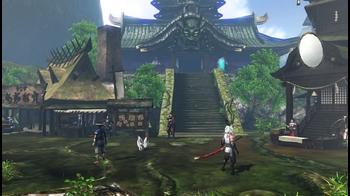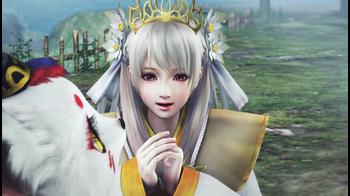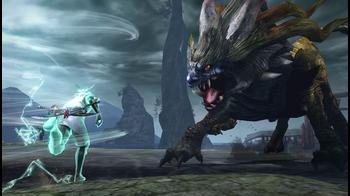
Toukiden: Age of Demons Review
While developer Omega Force is generally known for the Dynasty Warriors series, they sometimes like to step a little outside of their comfort zone and work on a project that sits in a different genre than what they are normally used to.
Toukiden deviates slightly from their normal bread-and-butter into something more akin to Capcom’s Monster Hunter series, a franchise that a lot of games lately have been trying to chase after especially given the distinct lack of an entry for Sony’s newest handheld platform. While Toukiden does offers up a compelling experience for those looking for something along that same line, it could use with some work to help elevate it above the copycats.
After being recruited into a band known as Slayers whose jobs are to get out there and eradicate the murderous Oni horde that are feasting upon the human populace, the player will take on a number of different missions to either push back the encroaching demons or participate in quests issued from other characters or villagers. There is a lot more going on than what appears on the surface, and players will slowly start to unravel that mystery as the story goes on.
For the most part, the game controls rather well. There is a clear animation priority in combat as one would expect in this genre, where you are committed to your attack pattern as soon as you begin hitting buttons, but being able to quickly roll away from an enemy’s attack or hop back up on my feet if I had been knocked down kept the action running at a fever pitch. I always felt like I was in complete control of what my character was doing.
Unfortunately, the same can’t be said for the targeting. The lock-on feature can be so erratic that it took me completely by surprise when I was able to actually focus on my intended target. The game also makes very little use of the Vita’s features. The only thing that happens when you touch the screen is that it enables the “Eye of Truth” mode which lets players see the condition of a boss’s limbs, hidden (and visible) items on the field, and health bars. Tapping the map on the top right causes it to zoom in and out. You can set the rear touchpad to perform one of two different combinations of buttons which is nice, but that’s it.
It would have been nice if this was perhaps assigned that feature to a button and maybe instead allow the ability to poke the screen to designate a target. It felt like a lot of the time in order to avoid the issues with lock-on, I would have to contort my fingers to move around with the left analog stick, aim the trajectory of my arrow with the right analog stick, and shoot with the Square button when I felt I had lined up the shot on a particular part of a boss's body, all of this while having to put up with a fast-moving target.
Aside from just bringing your weapon to the field, there are also a large number of Mitama (essences of historical figures from Japanese history whose souls were devoured by the Oni) to obtain and equip. These spirits are categorized by class such as Speed, Defense, Healing, and Attack, with each one granting different abilities for players to take advantage of, allotting four active spells mapped to the face buttons and three passive skills that boost a player’s core capability, such as being able to regain stamina a lot faster or increase the number of times they can use a certain spell. Mitama can be leveled up through continued use to unlock more functions.
There is a healthy mix of weapons and armor to craft using different materials scavenged from around the different maps or from bosses themselves after hacking away at the different parts of their bodies and absorbing the fallen remains.
Each new boss or mob brought with it a new armor set or weapon imbued with its own stats and elemental effects, with hundreds, if not thousands of combinations to be had overall. This allows players to show off their own distinct look, even if there is no leveling system to be had here.
What was the biggest draw for me during Toukiden was just how much effort went into the story. While titles like Gods Eater Burst buckled a bit under its own narrative, the story here is presented in a simple but evocative fashion, thanks in large part to the excellent voice acting. I guess it helps that the only option here is the Japanese audio track, but what it does is help to provide what is arguably an authentic experience.
In what would otherwise be a rather silly scenario of a world overrun with mythological demons is grounded with the conviction that the actors bring to their characters. I could feel the sheer emotion swell in many of the more dramatic moments over the course of the game, and I appreciated the commitment to character development, even if I had decided early on who my core party would consist of.
I will say that I felt there were a few glaring caveats that I hope can be addressed in the future if a sequel is ever released. For example, boss variety didn’t start to really kick in until the second half of the game, so I was stuck having to face the same creatures over and over multiple times during many of the story missions - some that were simply palette-swapped with “harder” versions of the same boss.
This became increasingly aggravating having to deal with, especially when many of the latter battles can take around thirty minutes to complete, especially during some cases where I wind up having not obtained the exact item I needed to make my next weapon.
For the normal mob creatures, you may get a few different types, but that’s about it. Taking a look at the in-game database, there is only a half dozen base versions of these monsters with the aforementioned palette-swapping to make them appear slightly more aggressive.
Visually, Toukiden looks really good. All of the character models are drawn at a high resolution with a nice attention to detail especially when it came to the boss creatures, serving up as a nice showcase for what the Vita is capable of displaying. The action also ran very smooth, and only seemed to hitch during one of the boss battles towards the end of the game where there was a lot of activity on the screen.
Party AI is also very competent - I never had an issue where my friends would rush into battle only to get themselves killed, and seemed to be fully aware of what the enemy was trying to do at any given moment. Sure, at times I did wish there was a way for me to give orders to perform functions such as attack a specific target since they seemed to prioritize item pickup over everything else, although I guess that isn’t necessarily the worst thing in the grand scheme of things.
If you couldn't tell already, Toukiden derives many of its elements from the Monster Hunter school of action and mission-based gameplay. The downside to this is that the game falls into still trods the same beaten path that other recent titles like Soul Sacrifice did an arguably better job at.
It doesn’t do anything exceptionally bold to help make it stand out from the crowd, instead falling in line with the others attempting to ride off the success of the one sitting on the mountaintop. On the bright side, it does serve up its own distinct blend of visual style and works as a far more approachable design than that of its counterparts, allowing one to quickly get a grasp of a game that moves at a much faster pace.
That isn’t to say I didn’t have a really good time playing Toukiden as evidence by anyone who follows me on Twitter. My experience with Toukiden was a rather lengthy one. I was able to beat the main story in just under 27 hours, but I had skipped the non-essential missions towards the end and left many of the quests sitting on the board.
There are also two additional chapters to complete that are there for players looking for a deeper challenge, and even exclusive multiplayer missions to take on that allows players to team up online or through local ad-hoc play. It’s fun to join up with a group of friends to take on the Oni forces together.
It may not do a specific thing exceptionally well, but as an overall package, the game delivers a lot of value for players to sink their teeth into, and comes recommended for those looking for a more stylistic approach to that very familiar formula. One thing is for sure - I would love to see Omega Force make a sequel, because there’s certainly a lot of promise to be found here and what is ultimately a solid foundation, especially with the interesting story and engaging characters.


